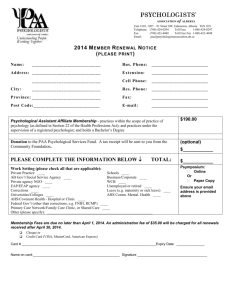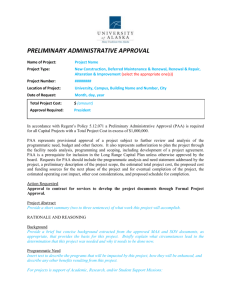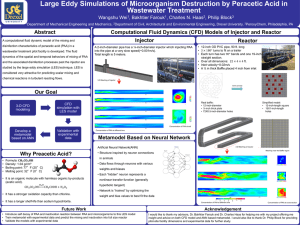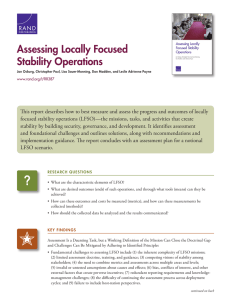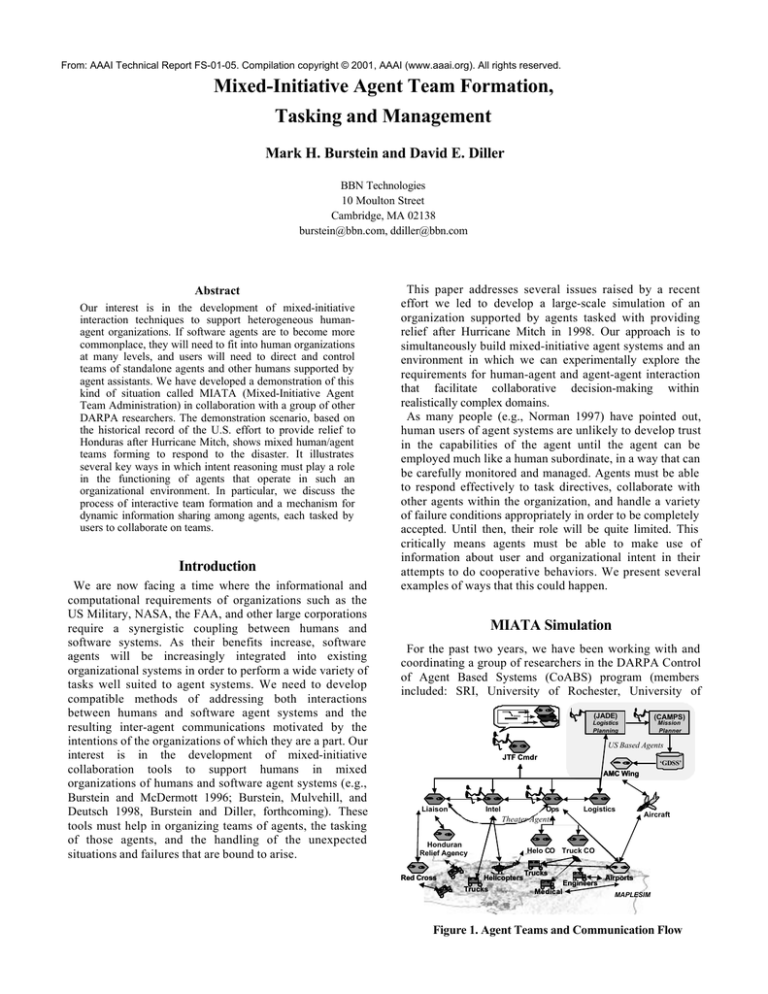
From: AAAI Technical Report FS-01-05. Compilation copyright © 2001, AAAI (www.aaai.org). All rights reserved.
Mixed-Initiative Agent Team Formation,
Tasking and Management
Mark H. Burstein and David E. Diller
BBN Technologies
10 Moulton Street
Cambridge, MA 02138
burstein@bbn.com, ddiller@bbn.com
Abstract
Our interest is in the development of mixed-initiative
interaction techniques to support heterogeneous humanagent organizations. If software agents are to become more
commonplace, they will need to fit into human organizations
at many levels, and users will need to direct and control
teams of standalone agents and other humans supported by
agent assistants. We have developed a demonstration of this
kind of situation called MIATA (Mixed-Initiative Agent
Team Administration) in collaboration with a group of other
DARPA researchers. The demonstration scenario, based on
the historical record of the U.S. effort to provide relief to
Honduras after Hurricane Mitch, shows mixed human/agent
teams forming to respond to the disaster. It illustrates
several key ways in which intent reasoning must play a role
in the functioning of agents that operate in such an
organizational environment. In particular, we discuss the
process of interactive team formation and a mechanism for
dynamic information sharing among agents, each tasked by
users to collaborate on teams.
Introduction
We are now facing a time where the informational and
computational requirements of organizations such as the
US Military, NASA, the FAA, and other large corporations
require a synergistic coupling between humans and
software systems. As their benefits increase, software
agents will be increasingly integrated into existing
organizational systems in order to perform a wide variety of
tasks well suited to agent systems. We need to develop
compatible methods of addressing both interactions
between humans and software agent systems and the
resulting inter-agent communications motivated by the
intentions of the organizations of which they are a part. Our
interest is in the development of mixed-initiative
collaboration tools to support humans in mixed
organizations of humans and software agent systems (e.g.,
Burstein and McDermott 1996; Burstein, Mulvehill, and
Deutsch 1998, Burstein and Diller, forthcoming). These
tools must help in organizing teams of agents, the tasking
of those agents, and the handling of the unexpected
situations and failures that are bound to arise.
This paper addresses several issues raised by a recent
effort we led to develop a large-scale simulation of an
organization supported by agents tasked with providing
relief after Hurricane Mitch in 1998. Our approach is to
simultaneously build mixed-initiative agent systems and an
environment in which we can experimentally explore the
requirements for human-agent and agent-agent interaction
that facilitate collaborative decision-making within
realistically complex domains.
As many people (e.g., Norman 1997) have pointed out,
human users of agent systems are unlikely to develop trust
in the capabilities of the agent until the agent can be
employed much like a human subordinate, in a way that can
be carefully monitored and managed. Agents must be able
to respond effectively to task directives, collaborate with
other agents within the organization, and handle a variety
of failure conditions appropriately in order to be completely
accepted. Until then, their role will be quite limited. This
critically means agents must be able to make use of
information about user and organizational intent in their
attempts to do cooperative behaviors. We present several
examples of ways that this could happen.
MIATA Simulation
For the past two years, we have been working with and
coordinating a group of researchers in the DARPA Control
of Agent Based Systems (CoABS) program (members
included: SRI, University of Rochester, University of
(JADE)
(CAMPS)
Logistics
Planning
Mission
Planner
US Based Agents
JTF Cmdr
‘GDSS’
AMC Wing
Liaison
Intel
Ops
Logistics
Theater Agents
Honduran
Relief Agency
Red Cross
Aircraft
Helo CO Truck CO
Helicopters
Trucks
Trucks
Engineers
Medical
Airports
MAPLESIM
Figure 1. Agent Teams and Communication Flow
Oregon CIRL, CMU, OBJS Inc., Kestrel Institute, and Yale
University) in developing a series of demonstrations of
mixed-initiative agent-based computing in the context of
large organizations. The working group and demonstrations
were called MIATA, for Mixed-Initiative Agent Team
Administration. The goal of these demonstrations is to
explore and validate the potential for heterogeneous agent
systems to support and function effectively in
collaboration with humans within dynamic, distributed
organizations.
Our main focus has been in a scenario with explicit roles
for a number of users and software agents in a number of
different offices, all coordinating to address a simulated
disaster relief scenario based directly on the historical
record of Hurricane Mitch, which devastated Honduras and
the surrounding area in 1998. Hurricane Mitch struck
Central America from October 26 to November 4 1998. It
was the second most devastating hurricane ever recorded
in the Western Hemisphere. 200 mph winds and 75 inches
of rain left a death toll of over 11,000, with thousands more
missing, and more than three million people left homeless or
otherwise seriously affected. Honduras was affected most
severely, with widespread flooding and devastation of its
transportation infrastructure and villages.
The demonstration shows users directing and interacting
with agents to:
• Form teams and assign tasks
• Gather intelligence about damage on the ground
by interacting with a simulation (MapleSim) of the
region.
• Plan for the deployment of relief supplies and
repair equipment
• Manage logistical resources and distribution of
supplies
• Respond to problems on the ground.
moved about the country. All interactions with the
MapleSim simulator are by KQML (Finin, Labrou, and
Mayfield, 1997) messages, mostly transported over the
CoABS GRID (GITI 2000), a mechanism designed to
support communications between different agent
frameworks. These messages enable the agents to change
location, gather information, and change the state of the
simulation world by performing a variety of basic relief
tasks. Tasks modeled include the distribution of food, water
and shelter, the providing of medical relief, and the
repairing roads and bridges.
A second class of agents, Task Management Agents, also
developed mostly in OMAR and PRS, schedule, task, and
monitor other agents. Often these agents are also used as
information collectors: collecting and disseminating
information gathered by and for other agents. Typically,
Task Management Agents manage field agents, but in
some cases they manage other Task Management Agents.
Examples of Task Management Agents in the disaster relief
scenario include Helicopter and Truck Company
Commander Agents, AMC Wing Commander Agents,
Truck and Helicopter Scheduling Agents, and the Red
Cross Relief Agent.
Finally, a third class of agents – really clusters of agents
— are the Personal Assistant Agents (PAAs). These
groups of agents work in a tightly coupled fashion to
support mixed-initiative interactions between the agent
organization and the human users. Work to date has
focused primarily on three Personal Assistant Agent
clusters: A cluster supporting the Joint Task Force (JTF)
Commander, modeled using the TRIPS system from the
University of Rochester, and PAAs supporting the JTF
Intelligence (J-2) staff and Operations (J-3) staff. The latter
two each manage their own teams of agents as well.
Agents communicate with users and other agents within
the military organization, as well as agents representing
non-governmental organizations like the Red Cross. Figure
1 shows a pictorial representation of the users, agents and
the communication flow between them. Field agents act
through a simulation of the ground state in Honduras as
the hurricane passed through (MapleSim, provided by
CMU). Users interacted with the organization at six
different points, but primarily through either mixed-initiative
tools performing specialized functions (logistics planning
and scheduling tools developed in prior efforts and then
‘agent-ized’), or through personal assistant agents
specialized to support specific command roles. Our focus in
this paper will be mostly on the latter.
The ground level simulator MapleSim models the actions
of the hurricane as well as a large number of ‘Field Agents’,
representing trucks, planes and helicopters and their
occupants. The OMAR agent framework at BBN and the
PRS system at SRI were the reactive plan execution systems
used to model the agents representing the vehicles’ drivers,
as well as the engineers, and medical relief teams that
Team Formation and Tasking
One of the key attributes of the Hurricane Mitch scenario
was that the organization that responded was a dynamically
formed team, called a Joint Task Force. These teams are
based on doctrine describing key team member roles and
responsibilities, but they are not pre-existing organizations
themselves. JTF teams are formed to address individual
crisis situations.
In order to model flexibly formed mixed human/agent
organizations, our agents use explicit models of the team
organizations that they could be asked to participate in.
Team models consist primarily of a set of potential team
intentions (capabilities) and a set of roles for agents to
play, describing the capabilities required and the lines of
authority between agents filling their agreed-upon roles.
Our objective was to model an interactive process between
a designated commander and his/her PAA as they formed a
JTF team, based on shared knowledge of this doctrine, and
knowledge of the intentions relating to team formation in
general.
The JTF Commander’s PAA was developed by integrating
OMAR agents with the TRIPS system (Ferguson and Allen
1998), from the University of Rochester. It consists of a
cluster of agents presenting a multi-model interface for
monitoring and managing agent team tasks, and a mapbased tool for interacting over domain elements. The TRIPS
system provided the spoken language capabilities for input
and output, the interpretation of user directives, and the
planning of responses. The integration was in many ways
similar to that described in (Burstein, Ferguson and Allen,
2000) for the integration of TRIPS and the CAMPS
scheduling system.
As part of our disaster relief scenario, the JTF Commander
directs the formation of the JTF support staff through a
spoken dialog with a PAA. As the dialog begins, the
human commander queries the PAA to determine what
other humans and their supporting PAAs are available to
perform a number of critical roles such as Intelligence (J-2),
Operations (J-3), and Logistics (J-4) as part the JTF team.
An early portion of the interaction between the JTF
Commander and his supporting PAA is shown in Figure 2.
All dialog is spoken unless otherwise indicated.
Cmdr.: Establish a Joint Task Force at Soto Cano.
PAA: Alright
Cmdr.: Show me the officers there.
PAA: <Displays a table of local officers>
Cmdr.: Assign Captain Smith to J-2.
PAA: Ok.
Cmdr.: Major Jones can be the J-3.
PAA: Alright.
Cmdr.: And make Captain Brown the J-4.
PAA: Ok.
Cmdr.: Show me the team objectives.
PAA: <Shows checklist of objectives for a JTF task
force.>
Cmdr.: :<Selects objectives based on orders
received> Inform the team.
…
Figure 3: Team formation dialog
Intentional models of agent team formation and
coordinated action have been described by a number of
researchers (e.g., Cohen, Levesque, and Smith 1997; Grosz
and Kraus 1996, 1999; Rich and Sidner 1997; Tambe and
Zhang 2000).To support the dialog of figure 3, we needed
to view the human commander’s intention to form a team as
itself a collaborative activity between the commander and a
PAA. That is, mixed-initiative team formation and
management, PAAs need a model of the protocols and
intentions involved that is itself a joint plan between the
PAA and its user. This shared plan is used by the PAA
when interpreting user directives and for reasoning about
how to support a human users intention to form or manage
a team. Figure 3 shows some key early parts of the model
we are developing of the intention/task hierarchy we
associate with this process. The upper tasks are performed
jointly, while expansions may have tasks primarily
performed by one party or the other. For tasks like
determining objectives, whose purpose is sharing
information, the expansion may simply be a dialog to
achieve a shared knowledge state. For others, like
assigning agents to roles, specific tasks can be done by the
PAA to support the process.
Team formation task models like that shown in the figure
can be used to establish a local context in which to
disambiguate user directives, and also reason about when it
is appropriate for the PAA to perform a supporting task.
For example, in the expansion of the Assign Roles
intention, nodes shown in gray are those that the PAA can
perform itself, in support of that joint intention. That is, it
can find candidate agents to fill roles, and it can perform the
inter-agent
recruitment
dialog
between
the
commander+PAA and other human+PAAs. This model
leaves to the user the job of making the final selections
among candidates identified for roles.
The model is useful for disambiguating user directives in
statements like ‘Assign Captain Smith to J-2’, which can be
interpreted in this context as suggesting a role assignment,
and hence result in the PAA initiating the role recruitment
protocol. In an alternate context, the same assertion might
be a directive to assign Captain Smith to be a member of the
subordinate J-2 (intelligence) team.
Manage Team
Monitor Tasks
Determine
Objectives
and Scope
Identify Roles
Assign Roles
Develop Plan/
Assign Tasks
For Each unassigned role
Identify
Candidates
Select Agent
for Role
Request
Agent Play
Role
Declined
Figure 3: Team Management Tasks
Team Role Recruitment
The team formation task model leads the PAA to initiate
the process of recruiting an agent to a team role whenever
the user has specified a selection. The interactions between
agents that start with a request to perform a tasks or accept
a team role assignment require a potentially extended
sequence of messages referred to as a conversational
policy (e.g., Bradshaw, et al. 1997). A recipient agent’s
decision to reply by accepting or rejecting the role (or task)
is a function of a number of factors, including:
♦ The agent having all of the capabilities for the role,
♦ The time availability of the agent
♦ The tasking agent’s authority over the recipient agent 1
For task requests, the following additional considerations
also apply:
♦ Its prior intentions (or not) to be cooperative (as by
having accepted role on the requester’s team), and
♦ The existence of other conflicting tasks or intentions.
Accepting a specific role on a doctrinally defined team
means accepting the joint intentions of the team as a whole,
and establishing intentions to perform the set of tasks
associated with the role, when required to do. The decision
to accept a role is, therefore, dependent upon the agent’s
ability to perform all potential tasks associated with the
role. If there are immediate tasks associated with the role,
then any pre-existing intentions it had that may conflict
with the responsibilities of the proposed would be
justification for declining. In principle, although we do not
address this in our current model, agents might also be able
to accept a role ‘with qualifications’; when they can
perform only a subset of its described capabilities, or have
other responsibilities taking some part of their time.
We believe that in a mixed human/agent environment, a
requestee declining a request to accept a role (or, more
generally, do a task) either because a task or resource
conflict exists, or because it otherwise lacks the capability
to perform the request, should report the reason(s) for
declining. This is extremely important in a mixed-initiative
environment, because it enables the tasking agent
(frequently, with a user) to try to respond in a way that
addresses the problem or resolves the resource conflict.
When tasks mostly originate from a team leader or
commander, who also has authority to shift resources, it is
the availability of these rationales that enables interactive
plan adaptation to occur.
As in other shared plan/shared intention models, once all
key roles have been assigned and accepted, all team
members are informed of the identities of the other team
members, their roles, and the initial team objectives. This
activity is triggered in our scenario by the ‘Inform the team’
command from the user.
Teams formation can also occur by the autonomous
actions of a Task Management Agent. In our disaster relief
scenario, while the upper echelon of the JTF was formed by
interactions between the human JTF commander and PAA,
supporting
subteams
were
sometimes
formed
autonomously by that team’s lead agent.
Status Reporting Policies
In our team framework, all assigned tasks have associated
with them a default intention to report on task status when
asked, or at completion. This intention is subject to
modification with each request. Information about to whom
(what agents) and how frequently to report task status
accompanies tasking requests. Although, by default, task
1
As a means of prioritizing tasks, only. We are assuming a
basic cooperative stance by the agents.
failures or completions are reported to the tasking agent,
this needn’t be the case for a variety of reasons. The tasker
may have an associate agent that manages status
information, or the tasker may have been an agent other
than the team leader, in which case multiple reporting lines
may be used, with potentially different levels of detail
required. For example, the JTF Commander may request the
J-2 (Intelligence officer and subteam) perform a survey of
damage in a region and report the results to another team
member, the operations officer (J-3). The J-3 would then be
told if that task failed, but a full status or failure report with
the reason for failure might only be sent to the Commander.
Agents may also do reasoning about whom to report on
failures and delays. These decisions can depend greatly on
knowledge of the team objectives, task dependencies, and
such things as resource control or allocation. For example,
the commander (a human) might direct the J-3 to ‘loan’ a
helicopter to J-2 to support information gathering. Having
done so, the J-2 could infer that the J-3, in addition to the
commander, must be informed if that helicopter is damaged
or delayed, because the resource was to be returned to the
J-3’s control for future use.
A related issue is how much to report about information
collected or problems encountered. In a large hierarchical
organization, it is desirable that only failures or delays in
major assigned tasks be reported to supervisory agents or
their users. Advice (Myers 1996) can be used to say when a
situation should be reported immediately versus
periodically, and in a detailed or summarized form, or not at
all. This kind of customized reporting was developed
initially in the TRAC system that implemented the J-2 team,
and is described in Myers and Morley (2001).
Failure Reporting
We view it as critically important in mixed human/agent
organizations that agents provide justifications when
declining requests, and explanations when reporting
current or anticipated failures or delays in tasks they have
accepted. This is because the people and/or agents
managing the team may be able to use this information to
make better resource management and task allocation
decisions to overcome the problems. As subordinate
agents fail on tasks or exceed the expected time to complete
assigned tasks, their manager may decide to give them more
time, find additional resources to support them, reassign
the tasks to other agents, perform tasks themselves, etc.
Which of these things to do requires information about the
failure. It does, however, place a burden on software agents
to explain their reasons for concluding they have or will
have failed – a requirement that is unusual in current-day
agent systems.
A related issue is how failure information propagates up
the chain of command ni a hierarchical organization. In
MIATA, only simple causal justifications could be reported
from most low-level agents (e.g., delivery failed because a
road was blocked). Task Management Agents reported
failure when tasks they had been assigned by a higher level
agent failed because a component task failed (whether they
intended to do the task themselves, or had intended a
subordinate do it).
One might think that it would be sufficient that an agent
report on failures only for the tasks it was assigned by
others, but there are many cases where patterns of failures
in low level subtasks can be worth reporting because they
cumulatively indicate the need for replanning. An example
here would be a mid-level Task Management Agent
noticing that many of the trucks under its command were
reporting failures to traverse roads in the same region due
to flooding. This information, if discovered, could
dramatically change the dispatcher’s planning for future
tasks in the same area.
Similar arguments apply for agents that do explicit task
planning and constrained resource reasoning, such as
schedulers. It can be quite difficult to come up with precise
explanations (in the sense of specific, single causes) for the
failure of a scheduler to schedule individual tasks among
many. Individual tasks may be left unscheduled (or be
scheduled late) due to the confluence of many constraints,
such as shared resource bounds, and multiple tight
deadlines. In a mixed-initiative environment where a
commander is relying on subordinates to do scheduling,
the most useful kinds of explanations to produce in such
cases are those that enable the commander to replan
strategically by making alternative resource allocation
decisions, or selectively prioritizing or relaxing deadlines.
Helpful ‘explanations’ therefore would include things such
as indications of which resource bounds or time bounds
were implicated in many tasks being delayed or failing to be
scheduled. For example, a scheduler that fails in an attempt
to replan after being told that ground agents cannot reach a
town due to flooded roads should report both the failure
and the condition that many roads were blocked. This
assists the user to consider a different kind of resource
(helicopter) to achieve the objective.
Cooperative information sharing
When a user is individually tasking the agents on a team,
he or she will either have to be very explicit about the
information passing expected between the agents, or else
the agent team needs to develop appropriate information
sharing strategies dynamically. Since it may be hard to
predict in advance what information each agent will need,
we saw it as important to address the problem of dynamic
information sharing.
Put generally, if team agents intent to support other team
agents’ intentions, how do the agents become aware of
what support they can provide? Must they be told of every
goal that each other agent is pursuing? Or is there a policy
by which they can be told when cooperation would be
useful?
Consider the dialog in Figure 4 from the MIATA scenario.
Cmdr:
Which are the hardest hit towns?
PAA: <Brings up a map of Honduras and highlights
towns.>
Cmdr: Which towns are most populated?
PAA: <Highlights another set of towns on the map.>
Cmdr: Which towns haven't we reached yet?
PAA: <Highlights another set of towns on the map.>
Cmdr: <Draws a region on the map.> Let's collect intel
in this area first.
PAA: Ok. <Gives task to J-2.>
Cmdr: <Draws a region on the map.> Provide relief in
this area.
PAA: Ok. <Gives task to J-3.>
Figure 4. JTF Commander tasking team agents
After an initial survey is completed by the J-2, its partial
findings are reported to the JTF commander’s PAA, who in
turn briefs the human JTF commander by displaying a
summary of the damage levels and indicating which towns
were found to have damage on a map. The commander’s
response is to direct each agent to begin their primary team
tasks by focusing in what are now observed to be severely
damaged regions. This directive causes the team agents to
reprioritize which towns they will address first. For the J-2,
this means completing its information collection task
relative to those towns, while for the J-3, it means planning
the delivery of goods to those towns.
The issue is how the J-3 is to become aware of the
information being collected by the J-2 that it needs for its
relief planning. In general, we would like these agents to
become aware of their potential cooperative information
sharing without the user having to direct that sharing.
To address this, we developed a model by which the
agents can communicate about their information sharing
needs, so that information support relationships can be
formed dynamically without a tremendous amount of intent
reasoning and situation awareness by each agent about the
state of every other agent in the organization. It requires a
fairly straightforward communications policy activated by
the formation of new intentions by each agent.
Using the model, agents, when given specific tasks, can
determine whom to tell about their status, failures, and
information that they discover that is potentially needed by
others on their team or in the larger organization. An
important goal was that it be flexible enough so that users
directing teams can initially make assumptions about
agents’ policies for information sharing, but change the
information flow behavior dynamically. Details of the model
summarized below are described in (Burstein and Diller,
forthcoming).
The approach is based on the announcement by each
agent of information requirements and anticipated future
capabilities to do information provision. Expected
information provision capabilities are based on intentions
that can lead the agent to acquire information. These
announcements to teammates establish the conditions for
cooperative information sharing.
Previous teamwork models (e.g., Tambe and Zhang, 2000)
have included preliminary general rules for some kinds of
information sharing among team members, based directly
on the goals of local teammates who share mutual team
objectives and have partial shared plans. For example, in
TEAMCORE there are generic rules for sharing information
about observations that indicate the goals of other team
agents have already been achieved or cannot be achieved.
One can imagine a variety of other rules also supporting
specific variations on the general principle that
cooperating agents should provide the information needs
of other agents based on their shared knowledge of the
plans that those agents are pursuing. The difficulty is the
amount of reasoning that may be required if the such policy
rules are in a domain or context independent fashion, and
the degree to which sharing of individual agents’ plans is
required to support those policies. This would be especially
problematic in large organizations, where the agents would
be overwhelmed by the reasoning required to anticipate the
needs of large numbers of other agents. The possibility for
this kind of reasoning being based directly on the full
sharing of each others’ plans is also limited in practice both
by the variety of kinds of software agents likely to be found
in an organization and by the need for interleaved action
and planning in a continuous environment. Agents would
need to reason not only about the information required as
preconditions to other agents’ plans, but the information
needed when those agents were forming their plans in a
particular context.
A simple approach to this problem, which works in some
cases, is to make it an explicit stated objective of a one
agent to acquire and provide particular kinds of information
to a teammate as part of a team plan. This approach is, in a
sense, the most direct way to engineer agent systems so
that key pieces of information are available to the agents
needing it. However, it is too brittle in several ways. First,
the information requirement of one agent must have been
explicitly anticipated by the developer of the plans of the
other agent. Second, information needs may be conditional
on circumstances, so it may be difficult to engineer reactive
plans that anticipate when to acquire and provide the
information at the right time, even if agents are sharing
information about their intentions as they are formed.
This technique is also unworkable in larger organizations.
The dispersal of information both within teams and also
between teams is critical to large organizations. In the
simulated MIATA organization, there are a number of
heterogeneous teams (Intelligence, Operations, Logistics,
Red Cross) that have a high degree of overlap in their
information requirements. For example, field agents, such as
Delivery Trucks and Engineers (who also use trucks) may
be working in overlapping regions and desire to traverse
many of the same roads and bridges, regardless of whether
they’re part of the Operations team, the Intelligence team,
or as part of the Red Cross. Helicopter teams can often
identify information of great utility to these trucks, and vice
versa. Passability information is needed for all of these
agents to plan routes. Furthermore, these agents, in
traveling, may obtain information which, while not relevant
to themselves, is of value to other agents who may or may
not be directly a member of the same team.
Our model tries to strikes a middle ground, by adding a
policy for explicit announcement of anticipated
information needs and provision capabilities so agents
who might have the ability to acquire the information, or by
happenstance gain access to the information, can be aware
of the others’ need and signal a capability to provide it. The
goal is promote sharing, to the extent possible, of the
critical information needs and capabilities with both local
team agents and those on remote teams within the larger
organization.
The advertisement messages are triggered either by the
acceptance of a role or when specific intentions are
adopted by an agent in support of individual or teams
goals:
Information Provision (IP) advertisements declare that
the agent sending the message has an intention to achieve
some purpose or execute some plan that results in it having
information of the specified type. This signals an intention
that it will answer queries with the identified classes of
content, or provide such information on receipt of a
subscription request. Information may be requested either
on a periodic or ‘as learned’ basis. Information Provision
advertisements are not retracted unless the original
intention is aborted. IP advertisements are denoted as
either Active (IPA) or Passive (IPP), depending upon
whether the agent is actively pursuing the acquisition the
information, or merely serving as a passive, but
opportunistic gatherer and provider of that information.
Information Requirements (IR) advertisements declare
that the agent sending the message has an intention to
achieve some objective requiring the information. The
requirement may be either for the purpose of planning how
to achieve the intent, execute a conditional plan, or for use
during execution (i.e., processing the information).
Simultaneously advertising an IR and IP over the same
class of content suggests the agent’s role as a ‘knowledge
source’ for that information in the future. The agent will
both collect the information from anyone who provides it
and provide the information when needed to others.
Furthermore, some ‘knowledge sources’, like the J-2 in
MIATA, are active sources, in the sense that they will
perform actions to acquire the information (or direct teams
that do so). Such agents issue IPA advertisements, which
further indicate that they may adapt existing plans acquire
content they do not have at the time queried in order to
acquire the information sooner.
IP and IR advertisements associated with an operation are
immediately announced to team members upon the agent’s
intention to perform that operation. An agent, upon
learning of an IP advertisement that matches the class of
content it requires, may initiate a subscription protocol with
the agent advertising the IP, enabling it to automatically
receive the desired information upon its availability, or with
a specified delivery schedule. The subscription request
details the specific information desired, the rate at which
the information should be delivered (e.g., on-occurrence,
on-completion, or periodic with a given period, such as
every once a day), and the level of detail to be provided
(e.g., full vs. a specified summary level). Subscriptions may
be removed after an information requirement ceases to exist.
JTF
Commander
Agent
Task:
Perform-Assessment
1
Task:
Provide-Relief
2
4
since J-3 already had received a similar message from the J2, J-3 issues a subscription request for the survey
information that is being collected (6). When the J-3 tasks
its trucks to begin delivering goods, they issue IRs for the
road information they each need for local planning (7 ).
These messages are forwarded to the J-2 (8), who responds
when the survey trucks find that information (9,10)
The information needed for this policy is part of the
characterizations of agent roles. An agent role, R(N, T, ρ, C,
I, M, S), includes six main elements: the name of the role
(N), the team of which this role is a member (T), the set of
resources required by this role, the capabilities to be
provided by agents filling the role (C), the default
intentions initiated by accepting the role (I), the set of roles
which are managers of agents in this role (M), and lastly,
the set of subordinate roles to this role (S ). IP and IR
advertisements are explicit aspects of capabilities and
intentions. Capabilities are things that role agents may be
asked intend to achieve, C(Sig,IP,IR,ρ,Rep). They are
described by these elements:
♦ A message signature (Sig) for requesting the capability
of the agent,
♦ Information provision (IP(π))
and
information
requirement (IR(π)) forms containing descriptions of
the type of content provided or required as a semantic
‘pattern’ (π), which is further refined as specific
intentions are formed for the capability, and the
advertisements created.
♦ Required resources (ρ),and finally,
♦ A set of default reporting guidelines (Rep).
Info-Required, Provided:
City Status, Road Status
J2/
INTEL
RE: IR
Road
Out
9
Info-Required:
City Status
Info-Required:
Info-Required
2
J3/
OPERATIONS
5
Road Status
8
IR&IP
Subscribe
6
3
IR
7
10
Figure 5. Information coordination protocol using IP and
IR advertisements
Figure 5 illustrates this process. In MIATA, the teams are
organized hierarchically, though that is not critical to our
model. What is important is that agents are often members
of more than one team. For example, the Operations (J-3)
agent is a member of the JTF staff, but also is leader of the
subordinate Operations team. These multi-team agents
enable the sharing of information across teams. IP and IR
messages are forwarded when received to all teammates on
teams other than the team from which the message
originated. In the figure, we see an example of the resulting
message traffic. At time (1), the commander tasks the J-2 to
survey the region. This causes an IP+IR message to all
teammates on both the commander’s team and the
subordinate J-2 team (2). At time (3), the J-3 forwards the
message to its subordinates. At time (4), the commander
tasks the J-3, causing IR messages (5) to be sent out. Also,
Reporting guidelines, Rep(t,P) are default information
subscription requests associated with a task. They include
a description of the report type (status, failure, problem,
result) and its information content, and a set of policies,
P(r,p,d) which includes the receiver (r), of the report, the
reporting period (p), which is the time interval for reporting,
but can also be on demand or upon the occurrence of an
event, and lastly the level of detail (d), to be included in the
report.
Conclusion
We have tried to illustrate some of the many roles that
intentional reasoning can play in the coordination of
dynamic team performance for organizations composed of
heterogeneous collections of users and software agents.
The discussion was based on our experience developing a
large-scale demonstration of this kind of situation in
collaboration with a six other agent research groups. The
model was motivated by the relative complexity of the
MIATA demonstration, containing over 100 agents and six
users, developed by different groups, all supporting a
relatively detailed simulation of a historically documented
hurricane disaster relief scenario. Due to the scale of the
development effort, many theoretical issues relating to the
intent inferences described here are only partially worked
out. However, we feel that the work thus far has given us
an important perspective on a number of the issues
involved, and the kinds of reasoning that will be required of
agents supporting such organizations.
The first part of our discussion focused on the role of task
models describing team formation and management
functions in the intent inferences resulting from the dialog
between a human team leader and a personal assistant
agent. Independent of task models within the domain of
activity that the team itself will pursue, this generic task
model will be needed to address the management of the
team itself.
We discussed the role of status reporting by agents in
supporting team leaders coordinating activity in dynamic,
changing environments. In particular, we note the
importance of explanation of failure as critical to effective
decisionmaking by managers supervising agent teams.
We also presented a framework for dynamic information
sharing among teams of humans and agents working as
parts of large, frequently hierarchical, organizations. The
key observation is that information needs, as well as agent
intentions, must be shared among teammates and across
organizations. In many cases, the information needs and
provision capabilities of agents will require wider
dissemination than the intentions of the agents. By using
an approach where the announcement of intentions is
accompanied by information about relevant information
needs and expected information acquisition, we can create
an environment where agents can develop their own
information flow models dynamically. This is critical to
effective workflow in mixed-initiative command and control
environments as it removes the burden from users who
might otherwise need to explicitly plan for and describe
which agents needed to communicate with each other to
achieve team objectives.
Acknowledgments. This work was funded under the
DARPA Control of Agent-Based Systems program through
contract F30602-98-C-0168.
References
Bradshaw,. J. M., Dutfield, S., Benoit, P., and Woolley, J. D.
1997. KAoS: Toward an Industrial-Strength Open Agent
Architecture. In J. Bradshaw (Ed.), Software Agents.
Cambridge, MA: MIT Press.
Burstein, M. H. and McDermott, D. 1996. Issues in the
development of human-computer mixed-initiative planning
systems, In B. Gorayska and J. Mey (Eds.) Cognitive
Technology, Elsevier Science, pp. 285-303.
Burstein, M. H., Mulvehill, A. M. and Deutsch, S. 1998. An
Approach to Mixed-Initiative Management of
Heterogeneous Software Agent Teams. In Proceedings of
the 1998 Hawaii International Conference on the Systems
Sciences.
Burstein, M. H., Ferguson, G. and Allen, J. 2000. Integrating
agent-based mixed-initiative control with an existing multiagent planning system. In Proceedings International
Conference on Multi-Agent Systems.
Burstein, M. H. and Diller, D. 2002. A Framework for
Dynamic Information Flow in Mixed-Initiative
Human/Agent Organizations. Applied Intelligence.
Forthcoming.
Cohen, P. R., Levesque, H. R., and Smith, I. 1997. On Team
Formation. In J. Hintikka, and R. Tuomela (Eds.),
Contemporary Action Theory. Synthese.
Deutsch, S. E. 1998. Interdisciplinary foundations for
multiple-task human performance modeling in OMAR. In
Proceedings of the 20th Annual Meeting of the Cognitive
Science Society, Madison, WI.
Ferguson, G. and Allen, J. 1998. TRIPS: An Integrated
Intelligent Problem-Solving Assistant. In Proceedings of
AAAI-98. AAAI Press.
Finin, T., Labrou, Y., and Mayfield, J. 1997. KQML as an
agent communication language in Jeff Bradshaw (Ed.),
Software Agents. Cambridge, MA: MIT Press.
Grosz, B. J. and Kraus, S. 1996. Collaborative plans for
complex group action. Artificial Intelligence, 86, 269-357.
Grosz, B. J. and Kraus, S. 1999. The evolution of Shared
Plans. In M. Wooldridge and A. Rao, Foundations and
Theories of Rational Agency, pp. 227-262.
GITI/ISX Grid Vision Team, “The CoABS Grid: Technical
Vision,” http://coabs.gobalinfotek.com, 2000.
Myers, K. L. 1996. Advisable Planning Systems. In A. Tate
(Ed.), Advanced Planning Technology. Menlo Park, CA:
AAAI Press.
Myers, K. L. and Morley, D. N. 2001 Directing agent
communities: An initial framework. In Proceedings of the
IJCAI-01 Workshop on Autonomy, Delegation and
Control: Integrating with Autonomous Agents.
Norman, D. A. 1997. How People Might Interact with
Agents. In J. Bradshaw (Ed.), Software Agents. Cambridge,
MA: MIT Press.
Rich, C. and Sidner, C. 1997. COLLAGEN: When Agents
Collaborate with People. In Proceedings of the
International Conference on Autonomous Agents (Agents
’97).
Tambe, M. 1997. Towards flexible teamwork. Journal of
Artificial Intelligence Research, 7, 83-124.
Tambe, M., and Zhang, W. 2000. Towards Flexible
Teamwork in Persistent Teams: Extended Report.
Autonomous Agents and Multi-agent Systems, 3, 159-183.

